Project Management Analysis of Oxfam Australia - MGMT20144
VerifiedAdded on 2022/09/23
|10
|2106
|32
Report
AI Summary
This report provides a comprehensive business case analysis of Oxfam Australia, examining its organizational structure, corporate governance, and operational environment. The analysis includes an assessment of the external and internal factors influencing the organization's performance, utilizing frameworks like Porter's 5 Forces and SWOT analysis. The report identifies and evaluates key risks faced by Oxfam Australia, particularly those related to fundraising, innovation, and program implementation. Furthermore, it explores the impact of specific business practices on the organization's performance, including labor rights, community grievance resolution, and gender equality. The functional departments of Oxfam Australia are also outlined, highlighting their roles in achieving the organization's mission of poverty alleviation and environmental sustainability. The report concludes by emphasizing Oxfam Australia's commitment to corporate social responsibility and its contributions to a better Australian society.
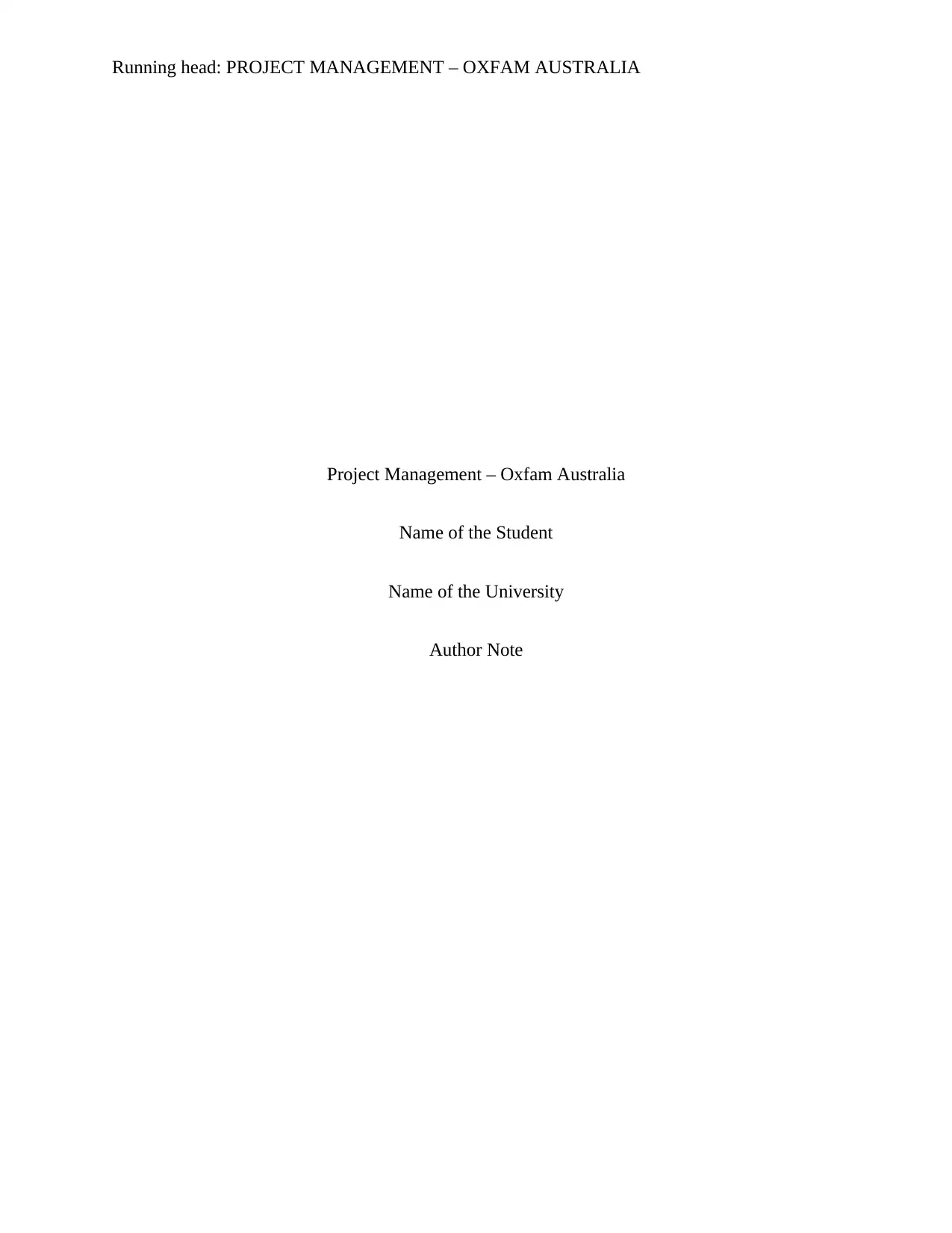
Running head: PROJECT MANAGEMENT – OXFAM AUSTRALIA
Project Management – Oxfam Australia
Name of the Student
Name of the University
Author Note
Project Management – Oxfam Australia
Name of the Student
Name of the University
Author Note
Paraphrase This Document
Need a fresh take? Get an instant paraphrase of this document with our AI Paraphraser
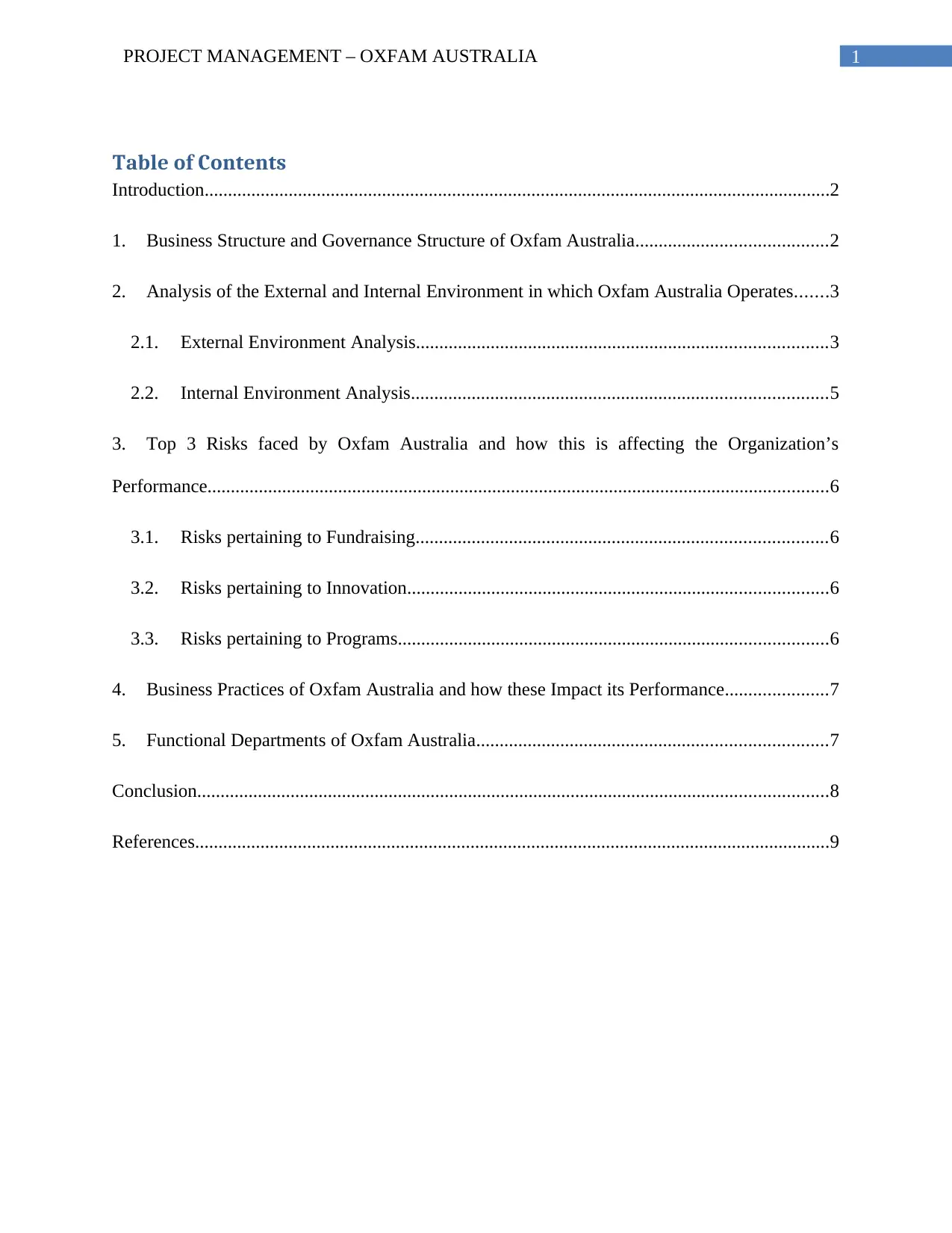
1PROJECT MANAGEMENT – OXFAM AUSTRALIA
Table of Contents
Introduction......................................................................................................................................2
1. Business Structure and Governance Structure of Oxfam Australia.........................................2
2. Analysis of the External and Internal Environment in which Oxfam Australia Operates.......3
2.1. External Environment Analysis........................................................................................3
2.2. Internal Environment Analysis.........................................................................................5
3. Top 3 Risks faced by Oxfam Australia and how this is affecting the Organization’s
Performance.....................................................................................................................................6
3.1. Risks pertaining to Fundraising........................................................................................6
3.2. Risks pertaining to Innovation..........................................................................................6
3.3. Risks pertaining to Programs............................................................................................6
4. Business Practices of Oxfam Australia and how these Impact its Performance......................7
5. Functional Departments of Oxfam Australia...........................................................................7
Conclusion.......................................................................................................................................8
References........................................................................................................................................9
Table of Contents
Introduction......................................................................................................................................2
1. Business Structure and Governance Structure of Oxfam Australia.........................................2
2. Analysis of the External and Internal Environment in which Oxfam Australia Operates.......3
2.1. External Environment Analysis........................................................................................3
2.2. Internal Environment Analysis.........................................................................................5
3. Top 3 Risks faced by Oxfam Australia and how this is affecting the Organization’s
Performance.....................................................................................................................................6
3.1. Risks pertaining to Fundraising........................................................................................6
3.2. Risks pertaining to Innovation..........................................................................................6
3.3. Risks pertaining to Programs............................................................................................6
4. Business Practices of Oxfam Australia and how these Impact its Performance......................7
5. Functional Departments of Oxfam Australia...........................................................................7
Conclusion.......................................................................................................................................8
References........................................................................................................................................9
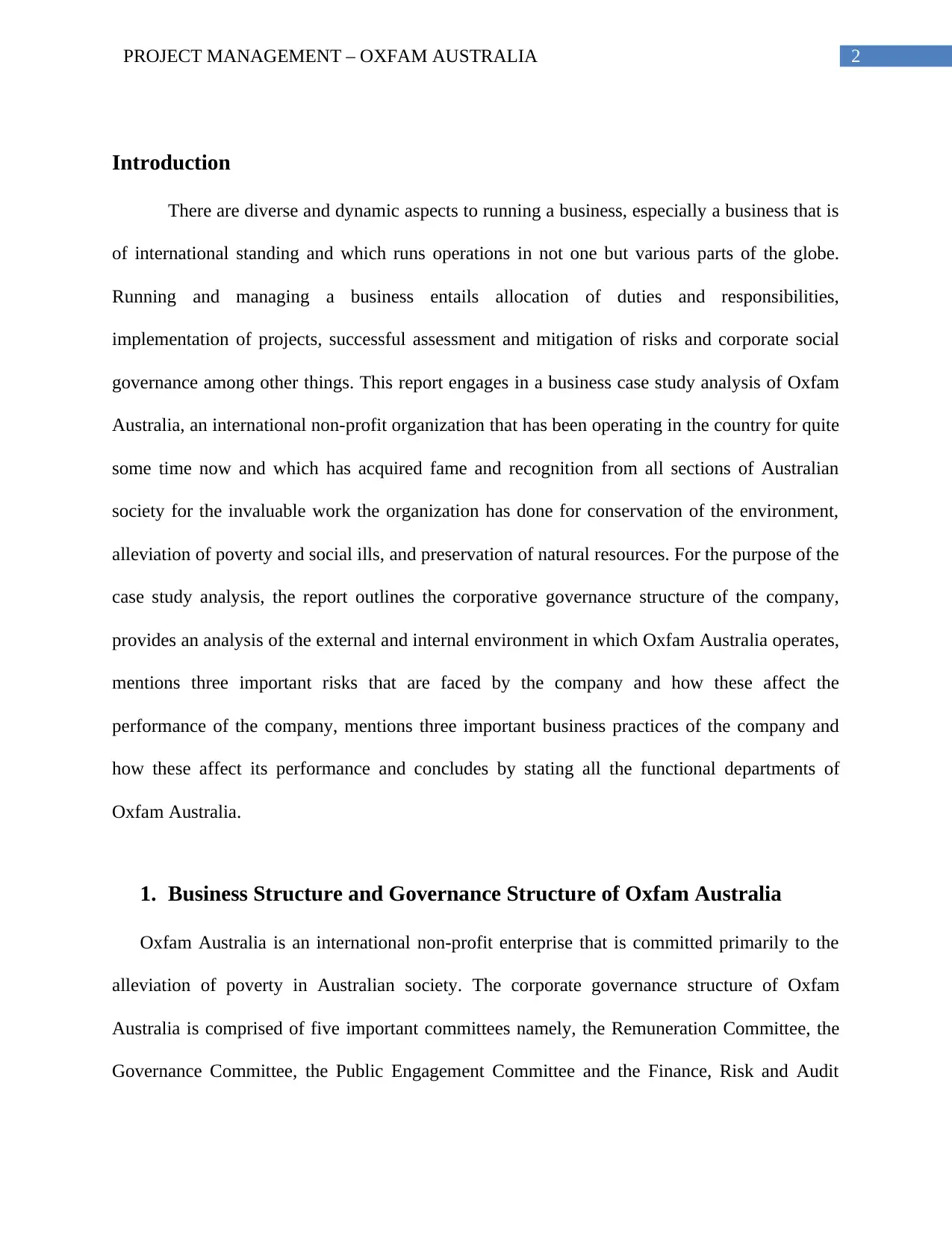
2PROJECT MANAGEMENT – OXFAM AUSTRALIA
Introduction
There are diverse and dynamic aspects to running a business, especially a business that is
of international standing and which runs operations in not one but various parts of the globe.
Running and managing a business entails allocation of duties and responsibilities,
implementation of projects, successful assessment and mitigation of risks and corporate social
governance among other things. This report engages in a business case study analysis of Oxfam
Australia, an international non-profit organization that has been operating in the country for quite
some time now and which has acquired fame and recognition from all sections of Australian
society for the invaluable work the organization has done for conservation of the environment,
alleviation of poverty and social ills, and preservation of natural resources. For the purpose of the
case study analysis, the report outlines the corporative governance structure of the company,
provides an analysis of the external and internal environment in which Oxfam Australia operates,
mentions three important risks that are faced by the company and how these affect the
performance of the company, mentions three important business practices of the company and
how these affect its performance and concludes by stating all the functional departments of
Oxfam Australia.
1. Business Structure and Governance Structure of Oxfam Australia
Oxfam Australia is an international non-profit enterprise that is committed primarily to the
alleviation of poverty in Australian society. The corporate governance structure of Oxfam
Australia is comprised of five important committees namely, the Remuneration Committee, the
Governance Committee, the Public Engagement Committee and the Finance, Risk and Audit
Introduction
There are diverse and dynamic aspects to running a business, especially a business that is
of international standing and which runs operations in not one but various parts of the globe.
Running and managing a business entails allocation of duties and responsibilities,
implementation of projects, successful assessment and mitigation of risks and corporate social
governance among other things. This report engages in a business case study analysis of Oxfam
Australia, an international non-profit organization that has been operating in the country for quite
some time now and which has acquired fame and recognition from all sections of Australian
society for the invaluable work the organization has done for conservation of the environment,
alleviation of poverty and social ills, and preservation of natural resources. For the purpose of the
case study analysis, the report outlines the corporative governance structure of the company,
provides an analysis of the external and internal environment in which Oxfam Australia operates,
mentions three important risks that are faced by the company and how these affect the
performance of the company, mentions three important business practices of the company and
how these affect its performance and concludes by stating all the functional departments of
Oxfam Australia.
1. Business Structure and Governance Structure of Oxfam Australia
Oxfam Australia is an international non-profit enterprise that is committed primarily to the
alleviation of poverty in Australian society. The corporate governance structure of Oxfam
Australia is comprised of five important committees namely, the Remuneration Committee, the
Governance Committee, the Public Engagement Committee and the Finance, Risk and Audit
⊘ This is a preview!⊘
Do you want full access?
Subscribe today to unlock all pages.

Trusted by 1+ million students worldwide
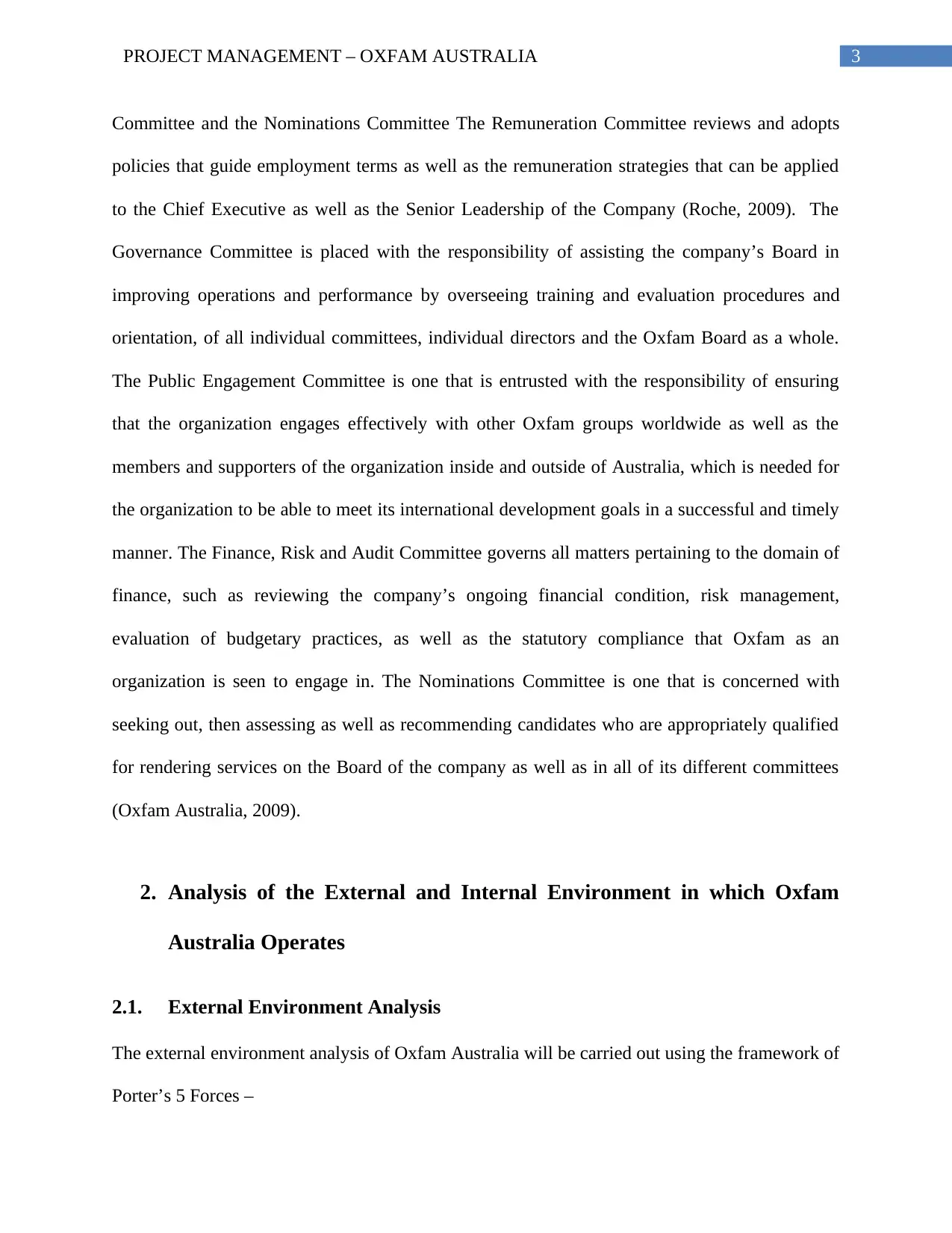
3PROJECT MANAGEMENT – OXFAM AUSTRALIA
Committee and the Nominations Committee The Remuneration Committee reviews and adopts
policies that guide employment terms as well as the remuneration strategies that can be applied
to the Chief Executive as well as the Senior Leadership of the Company (Roche, 2009). The
Governance Committee is placed with the responsibility of assisting the company’s Board in
improving operations and performance by overseeing training and evaluation procedures and
orientation, of all individual committees, individual directors and the Oxfam Board as a whole.
The Public Engagement Committee is one that is entrusted with the responsibility of ensuring
that the organization engages effectively with other Oxfam groups worldwide as well as the
members and supporters of the organization inside and outside of Australia, which is needed for
the organization to be able to meet its international development goals in a successful and timely
manner. The Finance, Risk and Audit Committee governs all matters pertaining to the domain of
finance, such as reviewing the company’s ongoing financial condition, risk management,
evaluation of budgetary practices, as well as the statutory compliance that Oxfam as an
organization is seen to engage in. The Nominations Committee is one that is concerned with
seeking out, then assessing as well as recommending candidates who are appropriately qualified
for rendering services on the Board of the company as well as in all of its different committees
(Oxfam Australia, 2009).
2. Analysis of the External and Internal Environment in which Oxfam
Australia Operates
2.1. External Environment Analysis
The external environment analysis of Oxfam Australia will be carried out using the framework of
Porter’s 5 Forces –
Committee and the Nominations Committee The Remuneration Committee reviews and adopts
policies that guide employment terms as well as the remuneration strategies that can be applied
to the Chief Executive as well as the Senior Leadership of the Company (Roche, 2009). The
Governance Committee is placed with the responsibility of assisting the company’s Board in
improving operations and performance by overseeing training and evaluation procedures and
orientation, of all individual committees, individual directors and the Oxfam Board as a whole.
The Public Engagement Committee is one that is entrusted with the responsibility of ensuring
that the organization engages effectively with other Oxfam groups worldwide as well as the
members and supporters of the organization inside and outside of Australia, which is needed for
the organization to be able to meet its international development goals in a successful and timely
manner. The Finance, Risk and Audit Committee governs all matters pertaining to the domain of
finance, such as reviewing the company’s ongoing financial condition, risk management,
evaluation of budgetary practices, as well as the statutory compliance that Oxfam as an
organization is seen to engage in. The Nominations Committee is one that is concerned with
seeking out, then assessing as well as recommending candidates who are appropriately qualified
for rendering services on the Board of the company as well as in all of its different committees
(Oxfam Australia, 2009).
2. Analysis of the External and Internal Environment in which Oxfam
Australia Operates
2.1. External Environment Analysis
The external environment analysis of Oxfam Australia will be carried out using the framework of
Porter’s 5 Forces –
Paraphrase This Document
Need a fresh take? Get an instant paraphrase of this document with our AI Paraphraser
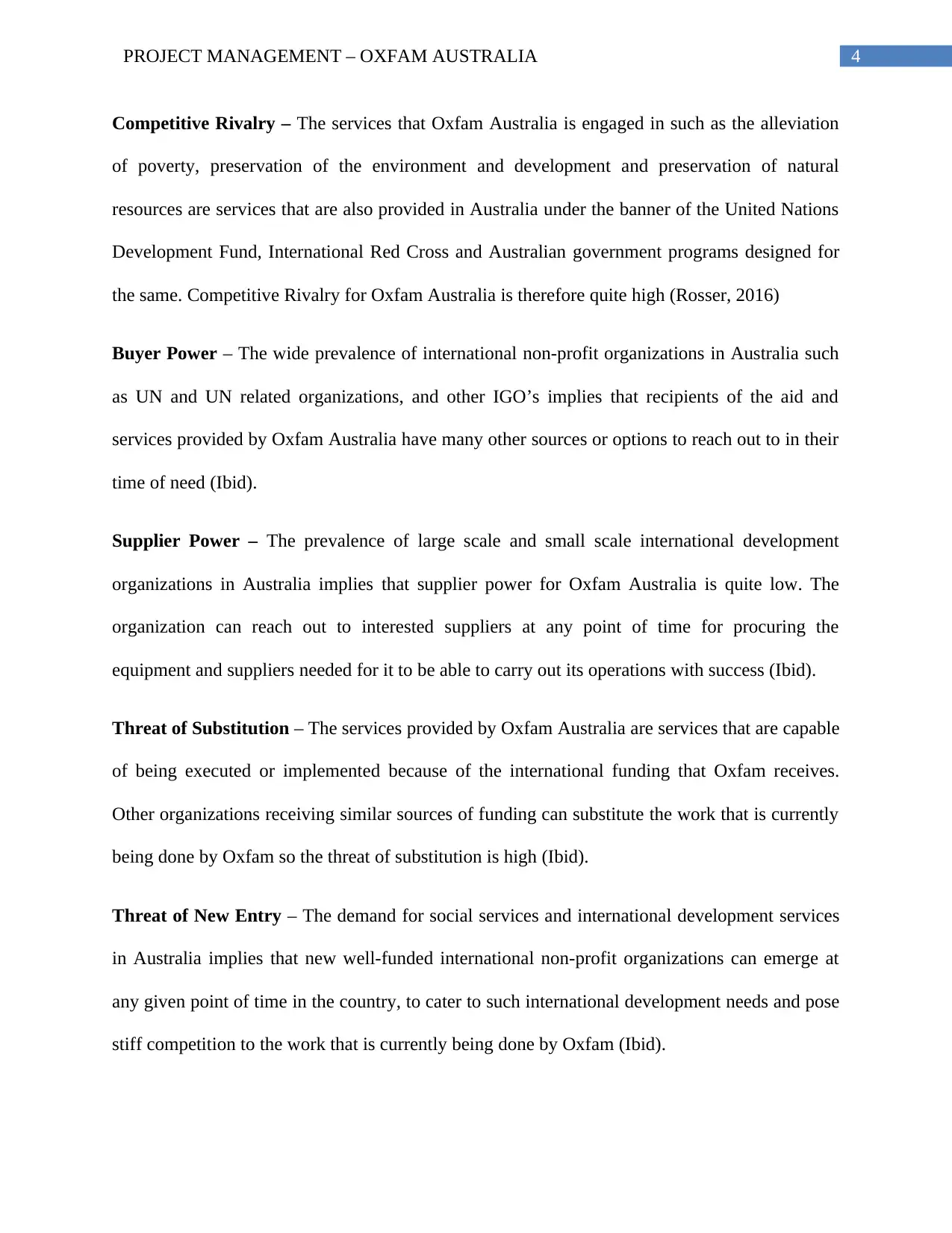
4PROJECT MANAGEMENT – OXFAM AUSTRALIA
Competitive Rivalry – The services that Oxfam Australia is engaged in such as the alleviation
of poverty, preservation of the environment and development and preservation of natural
resources are services that are also provided in Australia under the banner of the United Nations
Development Fund, International Red Cross and Australian government programs designed for
the same. Competitive Rivalry for Oxfam Australia is therefore quite high (Rosser, 2016)
Buyer Power – The wide prevalence of international non-profit organizations in Australia such
as UN and UN related organizations, and other IGO’s implies that recipients of the aid and
services provided by Oxfam Australia have many other sources or options to reach out to in their
time of need (Ibid).
Supplier Power – The prevalence of large scale and small scale international development
organizations in Australia implies that supplier power for Oxfam Australia is quite low. The
organization can reach out to interested suppliers at any point of time for procuring the
equipment and suppliers needed for it to be able to carry out its operations with success (Ibid).
Threat of Substitution – The services provided by Oxfam Australia are services that are capable
of being executed or implemented because of the international funding that Oxfam receives.
Other organizations receiving similar sources of funding can substitute the work that is currently
being done by Oxfam so the threat of substitution is high (Ibid).
Threat of New Entry – The demand for social services and international development services
in Australia implies that new well-funded international non-profit organizations can emerge at
any given point of time in the country, to cater to such international development needs and pose
stiff competition to the work that is currently being done by Oxfam (Ibid).
Competitive Rivalry – The services that Oxfam Australia is engaged in such as the alleviation
of poverty, preservation of the environment and development and preservation of natural
resources are services that are also provided in Australia under the banner of the United Nations
Development Fund, International Red Cross and Australian government programs designed for
the same. Competitive Rivalry for Oxfam Australia is therefore quite high (Rosser, 2016)
Buyer Power – The wide prevalence of international non-profit organizations in Australia such
as UN and UN related organizations, and other IGO’s implies that recipients of the aid and
services provided by Oxfam Australia have many other sources or options to reach out to in their
time of need (Ibid).
Supplier Power – The prevalence of large scale and small scale international development
organizations in Australia implies that supplier power for Oxfam Australia is quite low. The
organization can reach out to interested suppliers at any point of time for procuring the
equipment and suppliers needed for it to be able to carry out its operations with success (Ibid).
Threat of Substitution – The services provided by Oxfam Australia are services that are capable
of being executed or implemented because of the international funding that Oxfam receives.
Other organizations receiving similar sources of funding can substitute the work that is currently
being done by Oxfam so the threat of substitution is high (Ibid).
Threat of New Entry – The demand for social services and international development services
in Australia implies that new well-funded international non-profit organizations can emerge at
any given point of time in the country, to cater to such international development needs and pose
stiff competition to the work that is currently being done by Oxfam (Ibid).
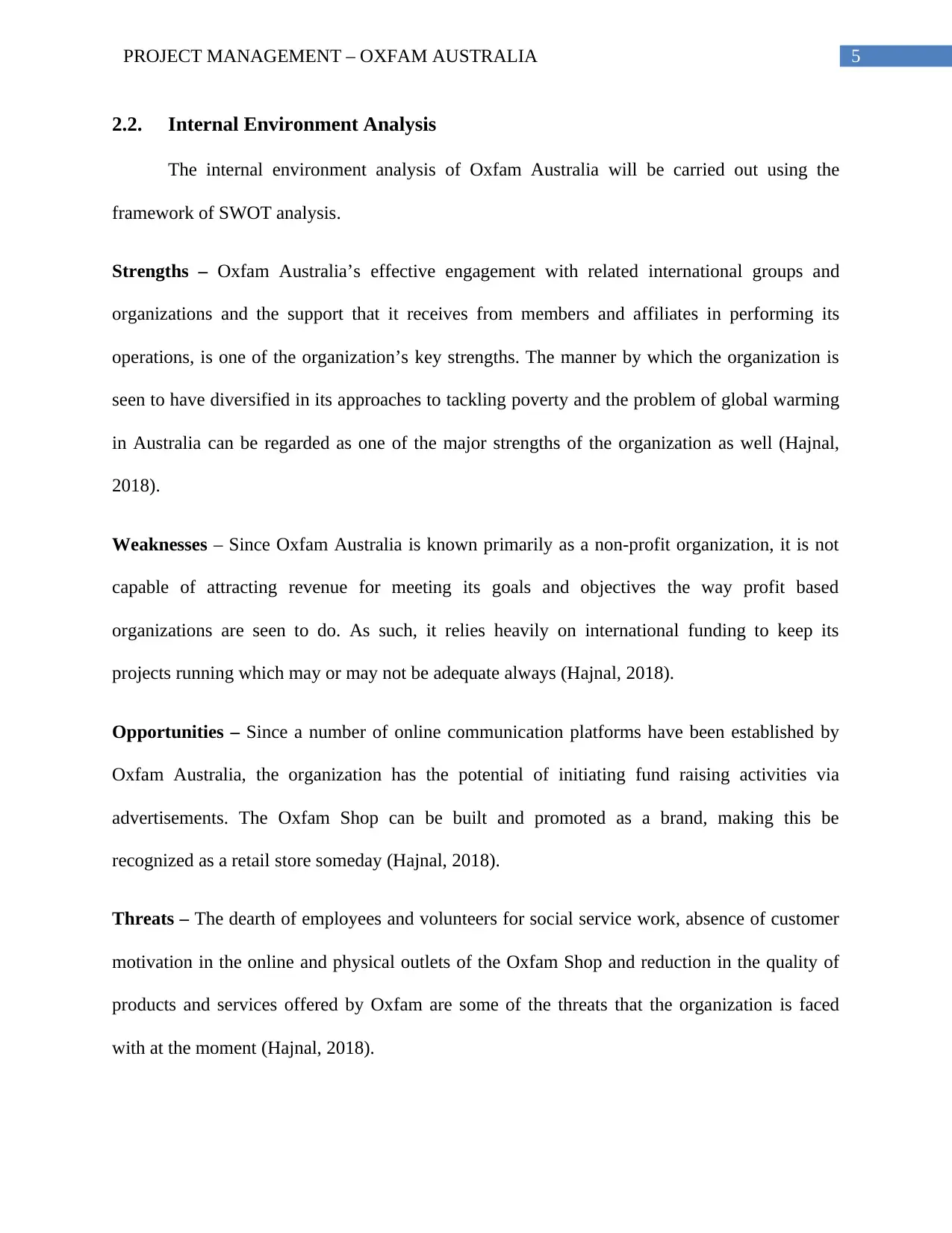
5PROJECT MANAGEMENT – OXFAM AUSTRALIA
2.2. Internal Environment Analysis
The internal environment analysis of Oxfam Australia will be carried out using the
framework of SWOT analysis.
Strengths – Oxfam Australia’s effective engagement with related international groups and
organizations and the support that it receives from members and affiliates in performing its
operations, is one of the organization’s key strengths. The manner by which the organization is
seen to have diversified in its approaches to tackling poverty and the problem of global warming
in Australia can be regarded as one of the major strengths of the organization as well (Hajnal,
2018).
Weaknesses – Since Oxfam Australia is known primarily as a non-profit organization, it is not
capable of attracting revenue for meeting its goals and objectives the way profit based
organizations are seen to do. As such, it relies heavily on international funding to keep its
projects running which may or may not be adequate always (Hajnal, 2018).
Opportunities – Since a number of online communication platforms have been established by
Oxfam Australia, the organization has the potential of initiating fund raising activities via
advertisements. The Oxfam Shop can be built and promoted as a brand, making this be
recognized as a retail store someday (Hajnal, 2018).
Threats – The dearth of employees and volunteers for social service work, absence of customer
motivation in the online and physical outlets of the Oxfam Shop and reduction in the quality of
products and services offered by Oxfam are some of the threats that the organization is faced
with at the moment (Hajnal, 2018).
2.2. Internal Environment Analysis
The internal environment analysis of Oxfam Australia will be carried out using the
framework of SWOT analysis.
Strengths – Oxfam Australia’s effective engagement with related international groups and
organizations and the support that it receives from members and affiliates in performing its
operations, is one of the organization’s key strengths. The manner by which the organization is
seen to have diversified in its approaches to tackling poverty and the problem of global warming
in Australia can be regarded as one of the major strengths of the organization as well (Hajnal,
2018).
Weaknesses – Since Oxfam Australia is known primarily as a non-profit organization, it is not
capable of attracting revenue for meeting its goals and objectives the way profit based
organizations are seen to do. As such, it relies heavily on international funding to keep its
projects running which may or may not be adequate always (Hajnal, 2018).
Opportunities – Since a number of online communication platforms have been established by
Oxfam Australia, the organization has the potential of initiating fund raising activities via
advertisements. The Oxfam Shop can be built and promoted as a brand, making this be
recognized as a retail store someday (Hajnal, 2018).
Threats – The dearth of employees and volunteers for social service work, absence of customer
motivation in the online and physical outlets of the Oxfam Shop and reduction in the quality of
products and services offered by Oxfam are some of the threats that the organization is faced
with at the moment (Hajnal, 2018).
⊘ This is a preview!⊘
Do you want full access?
Subscribe today to unlock all pages.

Trusted by 1+ million students worldwide
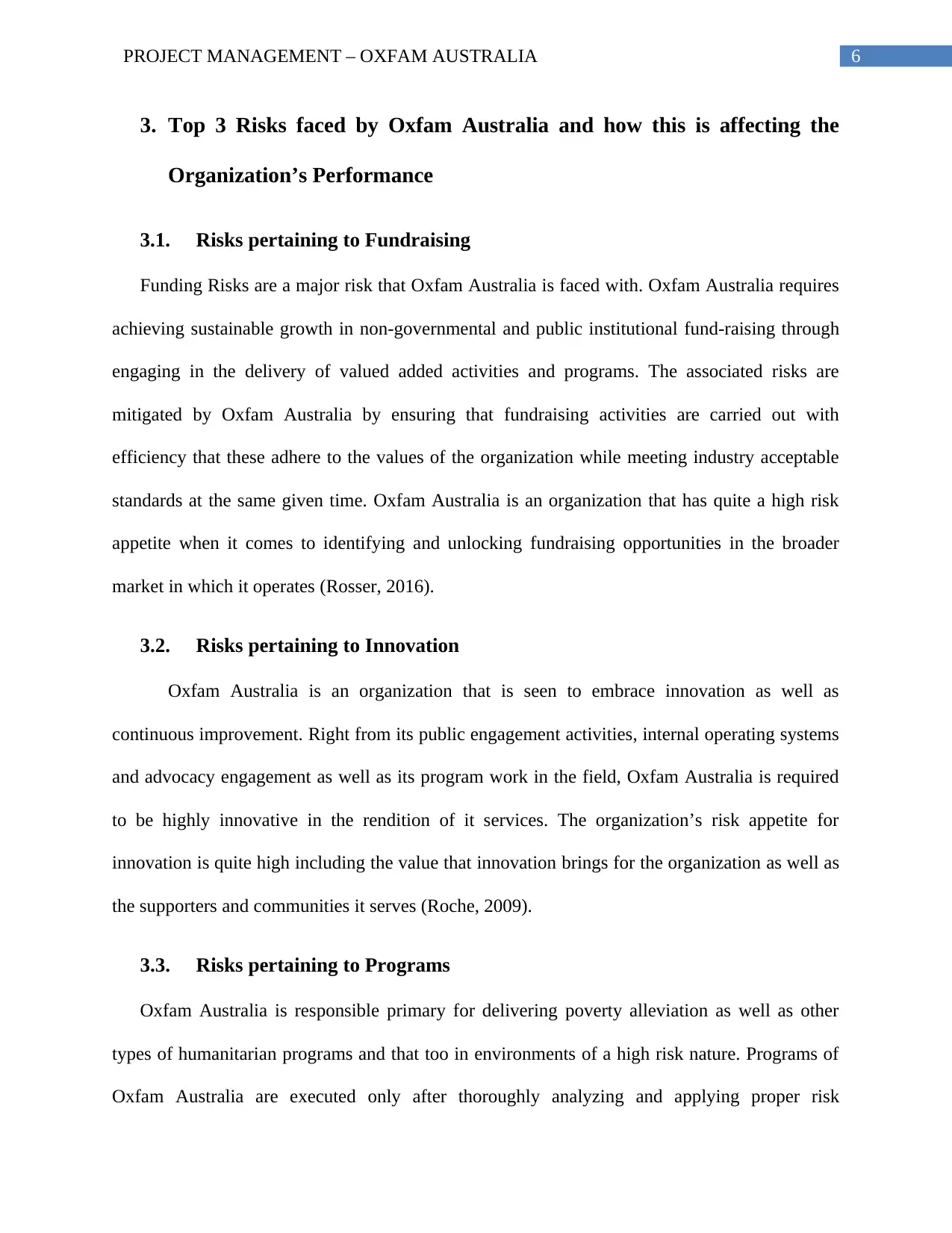
6PROJECT MANAGEMENT – OXFAM AUSTRALIA
3. Top 3 Risks faced by Oxfam Australia and how this is affecting the
Organization’s Performance
3.1. Risks pertaining to Fundraising
Funding Risks are a major risk that Oxfam Australia is faced with. Oxfam Australia requires
achieving sustainable growth in non-governmental and public institutional fund-raising through
engaging in the delivery of valued added activities and programs. The associated risks are
mitigated by Oxfam Australia by ensuring that fundraising activities are carried out with
efficiency that these adhere to the values of the organization while meeting industry acceptable
standards at the same given time. Oxfam Australia is an organization that has quite a high risk
appetite when it comes to identifying and unlocking fundraising opportunities in the broader
market in which it operates (Rosser, 2016).
3.2. Risks pertaining to Innovation
Oxfam Australia is an organization that is seen to embrace innovation as well as
continuous improvement. Right from its public engagement activities, internal operating systems
and advocacy engagement as well as its program work in the field, Oxfam Australia is required
to be highly innovative in the rendition of it services. The organization’s risk appetite for
innovation is quite high including the value that innovation brings for the organization as well as
the supporters and communities it serves (Roche, 2009).
3.3. Risks pertaining to Programs
Oxfam Australia is responsible primary for delivering poverty alleviation as well as other
types of humanitarian programs and that too in environments of a high risk nature. Programs of
Oxfam Australia are executed only after thoroughly analyzing and applying proper risk
3. Top 3 Risks faced by Oxfam Australia and how this is affecting the
Organization’s Performance
3.1. Risks pertaining to Fundraising
Funding Risks are a major risk that Oxfam Australia is faced with. Oxfam Australia requires
achieving sustainable growth in non-governmental and public institutional fund-raising through
engaging in the delivery of valued added activities and programs. The associated risks are
mitigated by Oxfam Australia by ensuring that fundraising activities are carried out with
efficiency that these adhere to the values of the organization while meeting industry acceptable
standards at the same given time. Oxfam Australia is an organization that has quite a high risk
appetite when it comes to identifying and unlocking fundraising opportunities in the broader
market in which it operates (Rosser, 2016).
3.2. Risks pertaining to Innovation
Oxfam Australia is an organization that is seen to embrace innovation as well as
continuous improvement. Right from its public engagement activities, internal operating systems
and advocacy engagement as well as its program work in the field, Oxfam Australia is required
to be highly innovative in the rendition of it services. The organization’s risk appetite for
innovation is quite high including the value that innovation brings for the organization as well as
the supporters and communities it serves (Roche, 2009).
3.3. Risks pertaining to Programs
Oxfam Australia is responsible primary for delivering poverty alleviation as well as other
types of humanitarian programs and that too in environments of a high risk nature. Programs of
Oxfam Australia are executed only after thoroughly analyzing and applying proper risk
Paraphrase This Document
Need a fresh take? Get an instant paraphrase of this document with our AI Paraphraser
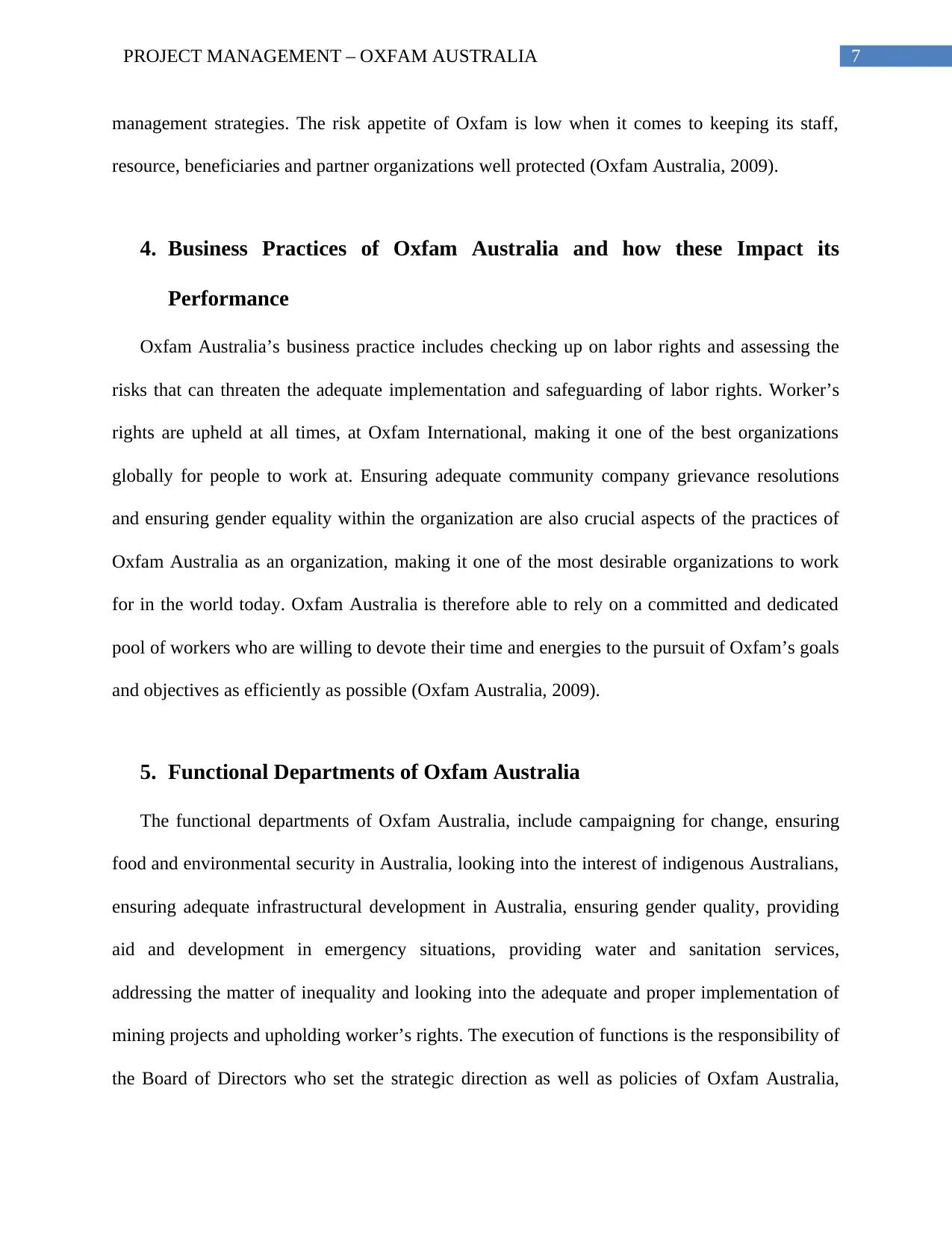
7PROJECT MANAGEMENT – OXFAM AUSTRALIA
management strategies. The risk appetite of Oxfam is low when it comes to keeping its staff,
resource, beneficiaries and partner organizations well protected (Oxfam Australia, 2009).
4. Business Practices of Oxfam Australia and how these Impact its
Performance
Oxfam Australia’s business practice includes checking up on labor rights and assessing the
risks that can threaten the adequate implementation and safeguarding of labor rights. Worker’s
rights are upheld at all times, at Oxfam International, making it one of the best organizations
globally for people to work at. Ensuring adequate community company grievance resolutions
and ensuring gender equality within the organization are also crucial aspects of the practices of
Oxfam Australia as an organization, making it one of the most desirable organizations to work
for in the world today. Oxfam Australia is therefore able to rely on a committed and dedicated
pool of workers who are willing to devote their time and energies to the pursuit of Oxfam’s goals
and objectives as efficiently as possible (Oxfam Australia, 2009).
5. Functional Departments of Oxfam Australia
The functional departments of Oxfam Australia, include campaigning for change, ensuring
food and environmental security in Australia, looking into the interest of indigenous Australians,
ensuring adequate infrastructural development in Australia, ensuring gender quality, providing
aid and development in emergency situations, providing water and sanitation services,
addressing the matter of inequality and looking into the adequate and proper implementation of
mining projects and upholding worker’s rights. The execution of functions is the responsibility of
the Board of Directors who set the strategic direction as well as policies of Oxfam Australia,
management strategies. The risk appetite of Oxfam is low when it comes to keeping its staff,
resource, beneficiaries and partner organizations well protected (Oxfam Australia, 2009).
4. Business Practices of Oxfam Australia and how these Impact its
Performance
Oxfam Australia’s business practice includes checking up on labor rights and assessing the
risks that can threaten the adequate implementation and safeguarding of labor rights. Worker’s
rights are upheld at all times, at Oxfam International, making it one of the best organizations
globally for people to work at. Ensuring adequate community company grievance resolutions
and ensuring gender equality within the organization are also crucial aspects of the practices of
Oxfam Australia as an organization, making it one of the most desirable organizations to work
for in the world today. Oxfam Australia is therefore able to rely on a committed and dedicated
pool of workers who are willing to devote their time and energies to the pursuit of Oxfam’s goals
and objectives as efficiently as possible (Oxfam Australia, 2009).
5. Functional Departments of Oxfam Australia
The functional departments of Oxfam Australia, include campaigning for change, ensuring
food and environmental security in Australia, looking into the interest of indigenous Australians,
ensuring adequate infrastructural development in Australia, ensuring gender quality, providing
aid and development in emergency situations, providing water and sanitation services,
addressing the matter of inequality and looking into the adequate and proper implementation of
mining projects and upholding worker’s rights. The execution of functions is the responsibility of
the Board of Directors who set the strategic direction as well as policies of Oxfam Australia,
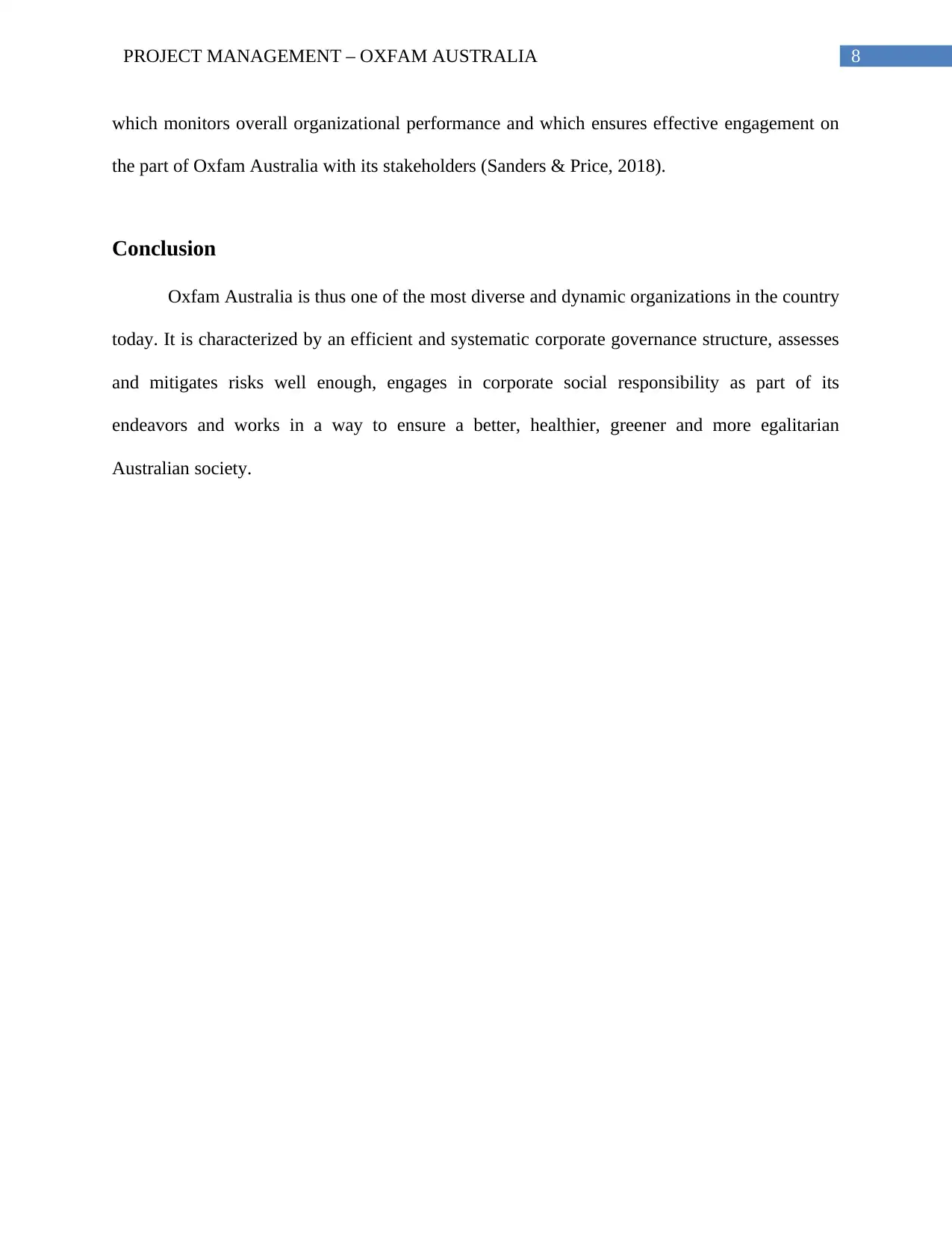
8PROJECT MANAGEMENT – OXFAM AUSTRALIA
which monitors overall organizational performance and which ensures effective engagement on
the part of Oxfam Australia with its stakeholders (Sanders & Price, 2018).
Conclusion
Oxfam Australia is thus one of the most diverse and dynamic organizations in the country
today. It is characterized by an efficient and systematic corporate governance structure, assesses
and mitigates risks well enough, engages in corporate social responsibility as part of its
endeavors and works in a way to ensure a better, healthier, greener and more egalitarian
Australian society.
which monitors overall organizational performance and which ensures effective engagement on
the part of Oxfam Australia with its stakeholders (Sanders & Price, 2018).
Conclusion
Oxfam Australia is thus one of the most diverse and dynamic organizations in the country
today. It is characterized by an efficient and systematic corporate governance structure, assesses
and mitigates risks well enough, engages in corporate social responsibility as part of its
endeavors and works in a way to ensure a better, healthier, greener and more egalitarian
Australian society.
⊘ This is a preview!⊘
Do you want full access?
Subscribe today to unlock all pages.

Trusted by 1+ million students worldwide
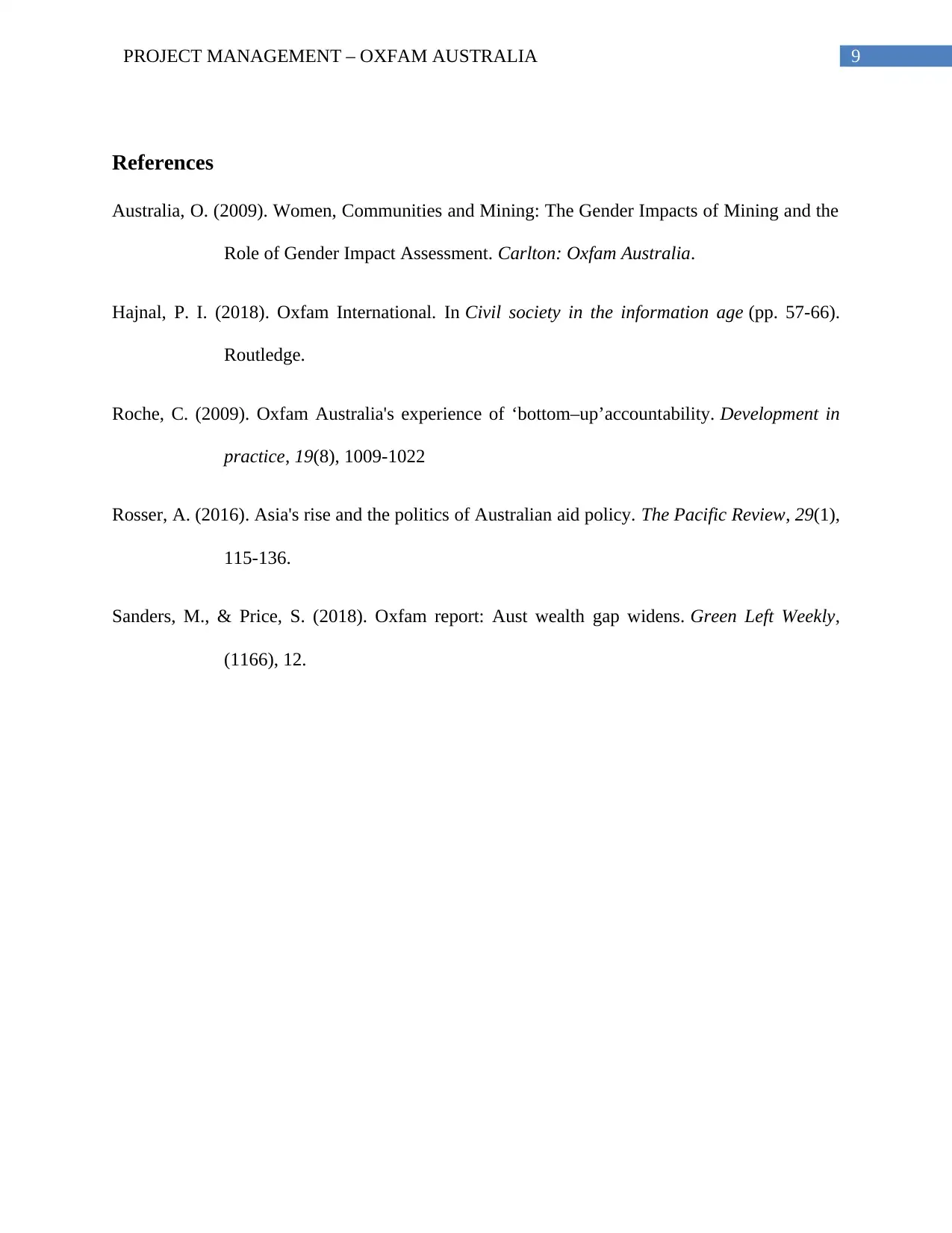
9PROJECT MANAGEMENT – OXFAM AUSTRALIA
References
Australia, O. (2009). Women, Communities and Mining: The Gender Impacts of Mining and the
Role of Gender Impact Assessment. Carlton: Oxfam Australia.
Hajnal, P. I. (2018). Oxfam International. In Civil society in the information age (pp. 57-66).
Routledge.
Roche, C. (2009). Oxfam Australia's experience of ‘bottom–up’accountability. Development in
practice, 19(8), 1009-1022
Rosser, A. (2016). Asia's rise and the politics of Australian aid policy. The Pacific Review, 29(1),
115-136.
Sanders, M., & Price, S. (2018). Oxfam report: Aust wealth gap widens. Green Left Weekly,
(1166), 12.
References
Australia, O. (2009). Women, Communities and Mining: The Gender Impacts of Mining and the
Role of Gender Impact Assessment. Carlton: Oxfam Australia.
Hajnal, P. I. (2018). Oxfam International. In Civil society in the information age (pp. 57-66).
Routledge.
Roche, C. (2009). Oxfam Australia's experience of ‘bottom–up’accountability. Development in
practice, 19(8), 1009-1022
Rosser, A. (2016). Asia's rise and the politics of Australian aid policy. The Pacific Review, 29(1),
115-136.
Sanders, M., & Price, S. (2018). Oxfam report: Aust wealth gap widens. Green Left Weekly,
(1166), 12.
1 out of 10
Related Documents
Your All-in-One AI-Powered Toolkit for Academic Success.
+13062052269
info@desklib.com
Available 24*7 on WhatsApp / Email
![[object Object]](/_next/static/media/star-bottom.7253800d.svg)
Unlock your academic potential
Copyright © 2020–2025 A2Z Services. All Rights Reserved. Developed and managed by ZUCOL.





